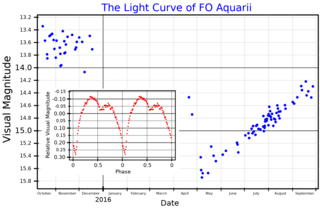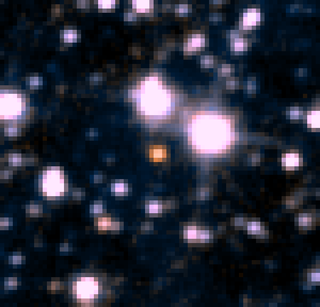
Brown dwarfs are substellar objects that have more mass than the biggest gas giant planets, but less than the least massive main-sequence stars. Their mass is approximately 13 to 80 times that of Jupiter (MJ)—not big enough to sustain nuclear fusion of ordinary hydrogen (1H) into helium in their cores, but massive enough to emit some light and heat from the fusion of deuterium (2H). The most massive ones can fuse lithium (7Li).

A rogueplanet, also termed a free-floating planet (FFP) or an isolated planetary-mass object (iPMO), is an interstellar object of planetary mass which is not gravitationally bound to any star or brown dwarf.

A subdwarf, sometimes denoted by "sd", is a star with luminosity class VI under the Yerkes spectral classification system. They are defined as stars with luminosity 1.5 to 2 magnitudes lower than that of main-sequence stars of the same spectral type. On a Hertzsprung–Russell diagram subdwarfs appear to lie below the main sequence.

A sub-brown dwarf or planetary-mass brown dwarf is an astronomical object that formed in the same manner as stars and brown dwarfs but that has a planetary mass, therefore by definition below the limiting mass for thermonuclear fusion of deuterium . Some researchers call them rogue planets whereas others call them planetary-mass brown dwarfs. They are sometimes categorized as Y spectral class brown dwarfs.
HD 147506, also known as HAT-P-2 and formally named Hunor, is a magnitude 8.7 F8 dwarf star that is somewhat larger and hotter than the Sun. The star is approximately 419 light-years from Earth and is positioned near the keystone of Hercules. It is estimated to be 2 to 3 billion years old, towards the end of its main sequence life. There is one known transiting exoplanet, and a second planet not observed to transit.

FO Aquarii is an intermediate polar star system in the constellation Aquarius. The white dwarf and companion star orbit each other with a period of approximately 4.85 hours. The system is famous for a very strong optical pulsation which occurs every 20.9 minutes, corresponding with the rotational period of the accreting white dwarf. Prior to 2016, the system's long-term optical brightness varied between apparent magnitude 12.7 and 14.2, but in early 2016, it faded to magnitude 15.8 and thereafter began a slow recovery to its normal brightness, behavior which is indicative of a temporary dropoff in the mass-transfer rate between the two stars.
Gliese 179 is a small red dwarf star with an exoplanetary companion in the equatorial constellation of Orion. It is much too faint to be visible to the naked eye with an apparent visual magnitude of 11.94. The system is located at a distance of 40.5 light-years from the Sun based on parallax measurements, but is drifting closer with a radial velocity of –9 km/s. It is a high proper motion star, traversing the celestial sphere at an angular rate of 0.370″·yr−1.

A planetary-mass object (PMO), planemo, or planetary body is, by geophysical definition of celestial objects, any celestial object massive enough to achieve hydrostatic equilibrium, but not enough to sustain core fusion like a star.
2MASS J21392676+0220226 is a brown dwarf located 34 light-years from Earth in the constellation Aquarius. Its surface is thought to be host to a massive storm, resulting in large variability of its color. It is a member of the Carina-Near moving group. This brown dwarf was discovered in the Two Micron All-Sky Survey (2MASS).

VHS J125601.92–125723.9 is a young triple brown dwarf system located in the constellation Corvus approximately 69.0 light-years from the Sun. The system consists of the equal-mass binary VHS J1256–1257AB and the distant planetary-mass companion VHS 1256–1257 b. In 2022, a continuous radio emission from the radiation belts surrounding VHS J1256–1257 was detected.

COCONUTS-2 b, or WISEPA J075108.79-763449.6, is a gas giant exoplanet that orbits the M-type star L 34-26. With a mass of 6.3 Jupiters, it takes over one million years to complete one orbit around the star, and it is 7,506 AU away from it.

Wolf 1130 is a nearby pre-cataclysmic triple star system consisting of a cold subdwarf of spectral type sdM3 (A), an ultramassive white dwarf (B) and a cold brown dwarf of spectral type sdT8 (C). Wolf 1130 is 54.1 light-years distant from earth.
CFHTWIR-Oph 98 b is a Super-Jupiter exoplanet that orbits CFHTWIR-Oph 98 A, a M-type star.









